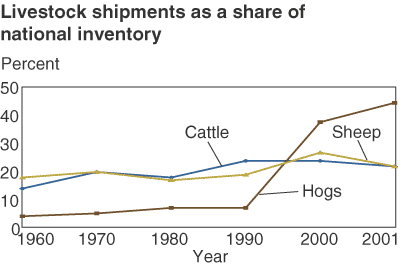Are More Livestock Hitting the Road?
- by Kenneth Mathews
- 11/1/2003
Recent concerns about the safety of the U.S. food supply and the potential for bioterrorism, as well as incidents like mad cow disease in Canada, have prompted a new look at livestock movements. The potential for transmitting disease—whether due to bioterrorism or a natural occurrence—increases when animals mix with other animals at a variety of locations. An important early step toward a cost-effective public strategy for managing such risks is to understand livestock mobility. Why are animals shipped long distances, and are livestock being moved more now than in the past?
Animals are often shipped long distances because doing so is frequently cheaper than shipping the feed needed to reach slaughter weight to the animals. Shipping livestock enables the efficient use of feed and forage (grass or hay) supplies that vary by region and season. This is most apparent when animals are moved from growing areas to finishing areas (where livestock are fed to slaughter weight) and then to slaughter plants.
Shipments of hogs, in particular, have increased dramatically—from under 10 percent of total (December 1) inventory in 1990 to more than 40 percent now. This increase reflects significant feeder pig imports from Canada, and the development of the hog industry in North Carolina and other States outside the Corn Belt. For example, pigs born in grain-deficient North Carolina may be weaned and moved to a growing/finishing facility in Iowa, where they consume corn, soybean meal, and other feeds grown nearby. Then, they may be shipped to slaughter plants often closer to major consumer markets in the U.S. and to export locations.
In contrast, cattle and sheep shipments have remained fairly steady at about 20 percent of inventories. Movements of cattle occur throughout the country, but especially into (and within) the Northern and Southern Plains. The top four cattle feeding States (Texas, Kansas, Nebraska, and Colorado) account for 65 percent of the feeder cattle supply and more than two-thirds of cattle slaughter. Sheep shipments have declined sharply since the early 1990s as the U.S. inventory continues its long-term decline. Colorado and California—two major sheep feeding and slaughter States—account for almost two-thirds of total interstate shipments.
This article is drawn from:
- Shields, D. & Mathews, K. (2003). Interstate Livestock Movements. U.S. Department of Agriculture, Economic Research Service. LDPM-10801.


